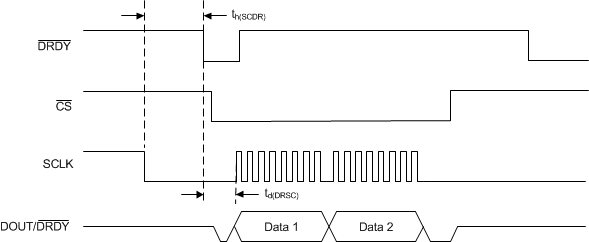ZHCSGA6A February 2017 – June 2017 ADS114S06 , ADS114S08
PRODUCTION DATA.
- 1 特性
- 2 应用
- 3 说明
- 4 修订历史记录
- 5 Device Family Comparison Table
- 6 Pin Configuration and Functions
- 7 Specifications
- 8 Parameter Measurement Information
-
9 Detailed Description
- 9.1 Overview
- 9.2 Functional Block Diagram
- 9.3
Feature Description
- 9.3.1 Multiplexer
- 9.3.2 Low-Noise Programmable Gain Amplifier
- 9.3.3 Voltage Reference
- 9.3.4 Clock Source
- 9.3.5 Delta-Sigma Modulator
- 9.3.6 Digital Filter
- 9.3.7 Excitation Current Sources (IDACs)
- 9.3.8 Bias Voltage Generation
- 9.3.9 System Monitor
- 9.3.10 Status Register
- 9.3.11 General-Purpose Inputs and Outputs (GPIOs)
- 9.3.12 Low-Side Power Switch
- 9.3.13 Cyclic Redundancy Check (CRC)
- 9.3.14 Calibration
- 9.4 Device Functional Modes
- 9.5 Programming
- 9.6
Register Map
- 9.6.1
Configuration Registers
- 9.6.1.1 Device ID Register (address = 00h) [reset = xxh]
- 9.6.1.2 Device Status Register (address = 01h) [reset = 80h]
- 9.6.1.3 Input Multiplexer Register (address = 02h) [reset = 01h]
- 9.6.1.4 Gain Setting Register (address = 03h) [reset = 00h]
- 9.6.1.5 Data Rate Register (address = 04h) [reset = 14h]
- 9.6.1.6 Reference Control Register (address = 05h) [reset = 10h]
- 9.6.1.7 Excitation Current Register 1 (address = 06h) [reset = 00h]
- 9.6.1.8 Excitation Current Register 2 (address = 07h) [reset = FFh]
- 9.6.1.9 Sensor Biasing Register (address = 08h) [reset = 00h]
- 9.6.1.10 System Control Register (address = 09h) [reset = 10h]
- 9.6.1.11 Reserved Register (address = 0Ah) [reset = 00h]
- 9.6.1.12 Offset Calibration Register 1 (address = 0Bh) [reset = 00h]
- 9.6.1.13 Offset Calibration Register 2 (address = 0Ch) [reset = 00h]
- 9.6.1.14 Reserved Register (address = 0Dh) [reset = 00h]
- 9.6.1.15 Gain Calibration Register 1 (address = 0Eh) [reset = 00h]
- 9.6.1.16 Gain Calibration Register 2 (address = 0Fh) [reset = 40h]
- 9.6.1.17 GPIO Data Register (address = 10h) [reset = 00h]
- 9.6.1.18 GPIO Configuration Register (address = 11h) [reset = 00h]
- 9.6.1
Configuration Registers
- 10Application and Implementation
- 11Power Supply Recommendations
- 12Layout
- 13器件和文档支持
- 14机械、封装和可订购信息
7.7 Switching Characteristics
over operating ambient temperature range, DVDD = 2.7 V to 3.6 V, IOVDD = DVDD to 5.25 V, andDOUT/DRDY load = 20 pF || 100 kΩ to DGND (unless otherwise noted)
| PARAMETER | TEST CONDITIONS | MIN | TYP | MAX | UNIT(1) | |
|---|---|---|---|---|---|---|
| tp(CSDO) | Propagation delay time, CS falling edge to DOUT driven | 0 | 25 | ns | ||
| tp(SCDO) | Propagation delay time, SCLK rising edge to valid new DOUT | 3 | 30 | ns | ||
| tp(CSDOZ) | Propagation delay time, CS rising edge to DOUT high impedance | 0 | 25 | ns | ||
| tp(STDR) | Propagation delay time, START/SYNC rising edge (or first SCLK rising edge of any command or data read) to DRDY rising edge | 2 | tCLK | |||
| tw(DRH) | Pulse duration, DRDY high | 24 | tCLK | |||
| tp(GPIO) | Propagation delay time, last SCLK falling edge of WREG command to GPIOx output valid | 3 | 100 | ns | ||
| SPI timeout per 8 bit(2) | 215 | tCLK | ||||
(1) tCLK = 1 / fCLK
(2) The SPI interface resets when an entire byte is not sent within the specified timeout time.

NOTE:
Single-byte communication is shown. Actual communication can be multiple bytes.
NOTE:
Single-byte communication is shown. Actual communication can be multiple bytes. Figure 3. RESET Pin and RESET Command Timing Requirements
Figure 3. RESET Pin and RESET Command Timing Requirements
 Figure 4. START/SYNC Pin Timing Requirements
Figure 4. START/SYNC Pin Timing Requirements
 Figure 5. START Command Timing Requirements
Figure 5. START Command Timing Requirements
 Figure 6. Read Data Direct (Without an RDATA Command) Timing Requirements
Figure 6. Read Data Direct (Without an RDATA Command) Timing Requirements
 Figure 7. GPIO Switching Characteristics
Figure 7. GPIO Switching Characteristics